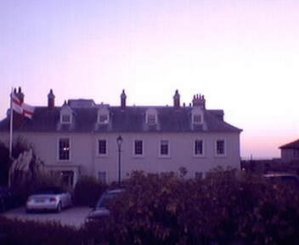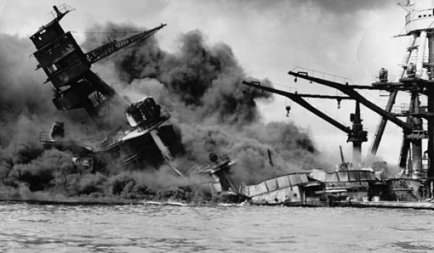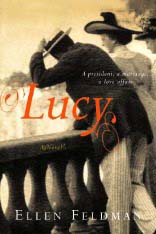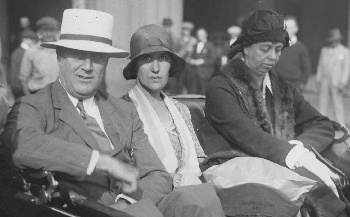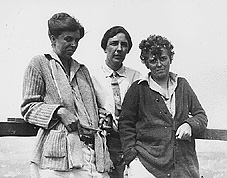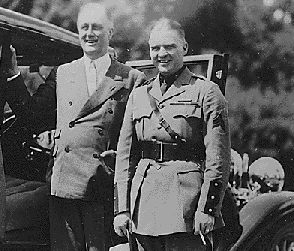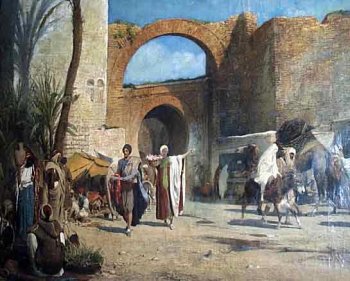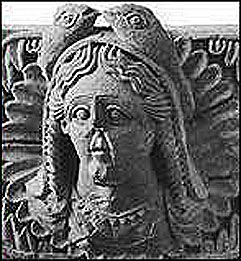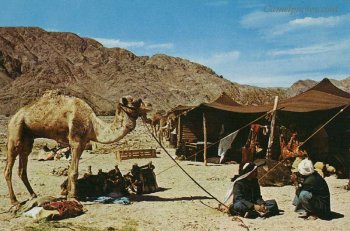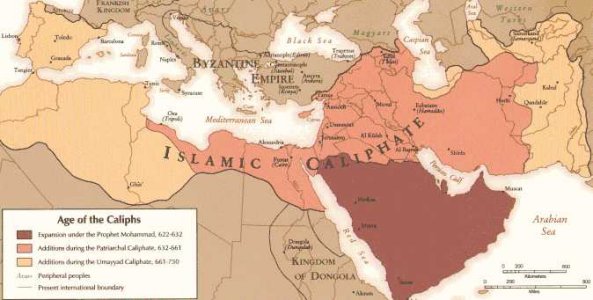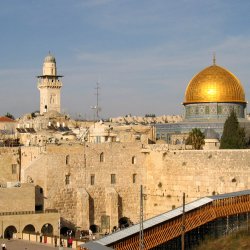The Shock Doctrine, Naomi Klein, 2007

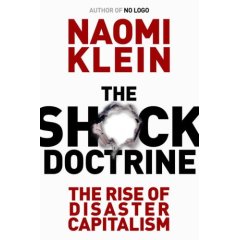
Milton Friedman 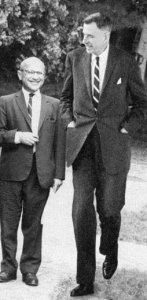 and John Kenneth Galbraith -The long and short of Twentieth Century Economics.
and John Kenneth Galbraith -The long and short of Twentieth Century Economics.
This book is a history of neoconservatism from its Milton Friedman Chicago roots in the 50s to today. The use of shock to effect neoconservative economic transformations started with the Indonesian military coup of 1965 and continued into Latin America (Chile, Brazil, Argentina, Uruguay) in the 1970s. Bolivia and Poland demonstrated in the 1980s that sufficient economic shock (inflation devaluation flight of capital) could coerce democratically elected governments to implement neocon economic “reforms”. Trinidad and Tobago showed that the IMF could effect an economic crisis by fabricating statistics and causing a flight of capital. With Russia and the 1997 Asian economic crisis, the neocons perfected the mechanism of crisis to engender massive transfers of wealth and ownership into private and foreign hands. And finally, the Bush administration neocons have learned to use armed force and the threat of force to create the crisis that can then be exploited to massively move ownership and wealth into new private hands. In fact, the force itself has largely been privatized. The public core is being emptied of all its critical functions.
Sukarno overthrown by Suharto 
Augusto Pinochet 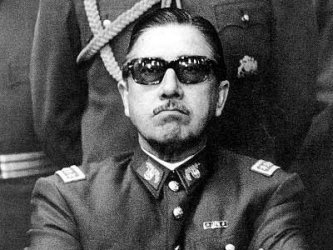
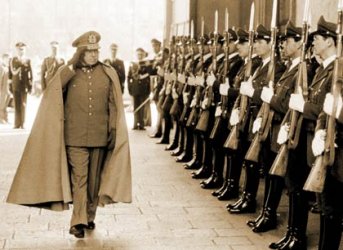
The theoretical underpinnings of neoliberalism (Neoconservatism) were born at the Chicago School of Economics in the 1950’s with Milton Friedman as chief guru although significant contributions were made by Harvard and Berkeley (in 1965, at the height of the Vietnam protests). Klein discovers that the Keynesian era with its New Deal, European and Japanese reconstruction under the Marshall Plan, and European social welfare programs were all made possible by the threat of Communism and radical socialism at the time. The Chicago (and Berkeley) boys (economists educated at these schools) were able to effect massive changes in Indonesia and in several Latin American countries such as privatization (often selling key national assets to foreign multinationals), removal of price controls, free trade, and reduction of social programs and safety nets because of crisis conditions in those countries. The crises led to or resulted in military coups and reigns of terror such as Pinochet in Chile and Suharto in Indonesia where thousands were arrested, tortured and died. Then the neoconservatives learned to exploit economic crises in a democracy without overthrowing the government with examples from Bolivia and South Africa.
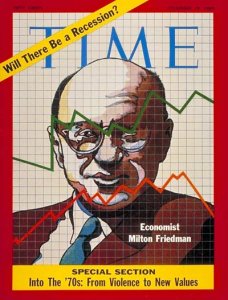
To aid in creating or expanding economic crisis worldwide, the Chicago School effectively took control of both the IMF and the World Bank, created after WWII to reduce economic crises. By insisting that massive foreign debt incurred by corrupt dictatorships or Apartheid regimes be honored, and by refusing aid and loans to desperate governments, the IMF and World Bank could manipulate and expand economic crises to create conditions (runaway inflation, massive unemployment) to force governments to implement neoconservative policies or to be overthrown by those who would be willing to implement such policies.
Milton Friedman with Reagan 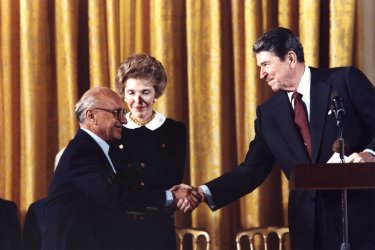
The Chicago School crisis addicts were certainly on a speedy intellectual trajectory. Only a few years earlier, they had speculated that a hyperinflation crisis could create the shocking conditions required for shock policies. Now a chief economist (Michael Bruno), an institution funded, by this time, with tax dollars from 178 countries and whose mandate was to rebuild and strengthen struggling economies, was advocating the creation of failed states because of the opportunities they provided to start over in the rubble.
Whistle Blower Davison Budhoo 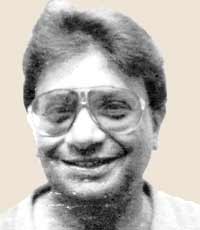
IMF staffer and whistle blower Davison Budhoo explained some tactics used to precipitate and expand an economic crisis, the manipulation and fabrication of statistics, which he called statistical malpractice. In the mid 1980s Budhoo wrote reports doubling the actual cost of labor in oil rich Trinidad and Tobago and fabricated huge unpaid government debts. This resulted in financial markets labeling the area a bad risk and cutting off financing. The resulting crisis forced the government to come begging to the IMF for a bailout. The IMF could then impose its conditions. Budhoo’s confessions never made the New York Times, The Wall Street Journal, or any major newspaper.
Deng’s New China 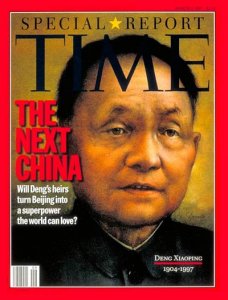
In China Deng Xiaoping had to call out the army with tanks in Tienanmen Square to put down the student rebellion against his economic policies,
Yeltsin with Clinton 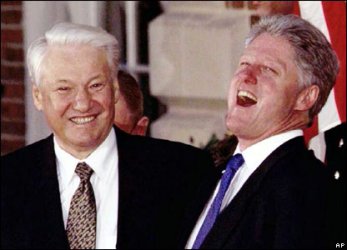
On Yeltsin and the remaking of the Russian economy:
…he (Yeltsin) ordered a reluctant army to storm the Russian White House (Parliament), setting it on fire and leaving charred the very building he had built his reputation defending just two years earlier. Communism may have collapsed without the firing of a single shot, but Chicago style capitalism, it turned out, required a great deal of gunfire to defend itself: Yeltsin called in five thousand soldiers, dozens of tanks and armored personnel carriers, helicopters and elite shock troops armed with automatic machine guns – all to defend Russia’s new capitalist economy from the grave threat of democracy.
With the conversion of China to free market policies under Deng Xiaoping and the collapse of the Soviet Union and overthrow of Communist regimes in Eastern Europe (Poland, Czechoslovakia, and Hungary), the Chicago school disciples were free to carry out their shock therapy throughout the world without fear of revolutionary reactions.
This volumes makes an interesting companion piece to the Legacy of Ashes. The CIA was directly involved in creating and exploiting virtually every crisis in Asia and Latin America, allowing the Chicago (or Berkeley) boys to remake their economies along Neoconservative lines. While the CIA history is a legacy of incompetence and blindness, the Neoconservative history is a history of success after success until the entire world is being remade in their image.
And that is how the crusade that Friedman began managed to survive the dreaded transition to democracy – not by its proponents persuading electorates of the wisdom of their world view, but by moving deftly from crisis to crisis, expertly exploiting the desperation of economic emergencies to push through policies that would tie the hands of fragile new democracies. Once the tactic was perfected, opportunities just seemed to multiply. The Volcher Shock (interest rates of 18-22%) would be followed by the Mexican Tequila Crisis in 1994, the Asian Contagion in 1997 and the Russian Collapse in 1998, which was followed shortly by one in Brazil. When these shocks and crises started to lose their power, even more cataclysmic ones would appear: tsunamis, hurricanes, wars and terrorist attacks. Disaster capitalism was taking shape
Nature Helps the Neocons 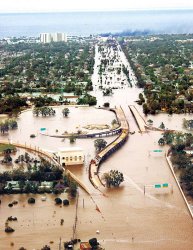

The movement that Milton Friedman launched in the 1950s is best understood as an attempt by multinational capital to recapture the highly profitable, lawless frontier that Adam Smith, the intellectual forefather of today’s neoliberals, so admired – but with a twist. Rather than journeying through Smith’s “savage and barbarous nations” where there was no Western law (no longer a practical option), this movement set out to systematically dismantle existing laws and regulations to re-create that earlier lawlessness. And where Smith’s colonists earned their record profits by seizing what he described as “waste lands” for “but a trifle”, today’s multinationals see government programs, public assets and everything that is not for sale as terrain to be conquered and seized – the post office, national parks, schools, social security, disaster relief and anything else that is publicly administered…Where Smith saw fertile green fields turned into profitable farmlands on the pampas and prairies, Wall Street saw “green field opportunities” in Chile’s phone system, Argentina’s airline, Russia’s oil fields, Bolivia’s water system, the United States’ public airwaves, Poland’s factories – all built with public wealth, then sold for a trifle. Then there are the treasures created by enlisting the state to put a patent and a price tag on life-forms and natural resources never dreamed of as commodities – seeds, genes, carbon in the earth’s atmosphere. By relentlessly searching for new profit frontiers in the public domain, Chicago School economists are like the mapmakers of the colonial era, identifying new waterways through the Amazon, marking off the location of a hidden cache of gold inside an Inca temple.
John Williamson, inheritor of Friedman’s guru status, explained the new strategy in January 1993:
One will have to ask whether it could conceivably make sense to think of deliberately provoking a crisis so as to remove the political logjam to reform. For example, it has sometimes been suggested in Brazil that it would be worthwhile stoking up a hyperinflation so as to scare everyone into accepting those changes…Presumably no one with historical foresight would have advocated in the mid-1930s that Germany or Japan go to war in order to get the benefits of super growth that followed their defeat. But could a lesser crisis have served the same function? Is it possible to conceive of a pseudo-crisis that could serve the same positive function without the cost of a real crisis?
The human costs of the IMF’s opportunism were nearly as devastating in Asia (1997 economic crisis) as in Russia. The International Labor Organization estimates that 24 million people lost their jobs in this period and that Indonesia’s unemployment rate increased from 4 to 12 percent. Thailand was losing 2,000 jobs a day at the height of the “reforms” – 60,000 a month. In South Korea, 300,000 workers were fired every month – largely the result of the IMF’s totally unnecessary demands to slash government budgets and hike interest rates. By 1999, South Korea’s and Indonesia’s unemployment rates had nearly tripled in two years. As in Latin America in the seventies, what disappeared in these parts of Asia was what was so remarkable about the region’s “miracle” in the first place: its large and growing middle class. In 1996 63.7 percent of South Koreans identified as middle class; by 1999 that number was down to 38.4 percent. According to the World Bank, 20 million Asians were thrown into poverty in this period of what Rodolfo Walsh would have called “planned misery”.
Rumsfeld and Cheney Enjoy New Wealth 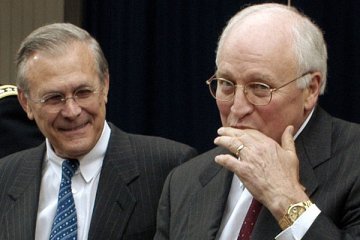
As proto-disaster capitalists, the architects of the War on Terror are part of a different breed from their predecessors(like Allan and John Foster Dulles in the 50s), one for whom wars and other disasters are indeed ends in themselves. When Dick Cheney and Donald Rumsfeld conflate what is good for Lockheed, Halliburton, Carlyle and Gilead with what is good for the United States and indeed the world, it is a form of projection with uniquely dangerous consequences. That’s because what is unquestionably good for the bottom line of these companies is cataclysm – wars, epidemics, natural disasters and resource shortages – which is why all their fortunes have improved dramatically since Bush took office. What makes their acts of projection even more perilous is the fact that, to an unprecedented degree, key Bush officials have maintained their interests in the disaster capitalism complex even as they have ushered in a new era of privatized war and disaster response, allowing them to simultaneously profit from the disasters they help unleash.
The right to limitless profit-seeking has always been at the center of neocon ideology. Before 9/11, demands for radical privatization and attacks on social spending fueled the neocon movement – Friedmanite to its core – at think tanks such as the American Enterprise Institute, Heritage, and Cato.
With the War on Terror, the neocons didn’t abandon their corporatist economic goals; they found a new, even more effective way to achieve them.
Iraq’s current state of disaster cannot be reduced either to the incompetence and cronyism of the Bush White House or to the sectarianism or tribalism of Iraqis. It is a very capitalist disaster, a nightmare of unfettered greed unleashed in the wake of war. The “fiasco” of Iraq is one created by a careful and faithful application of unrestrained Chicago School ideology.
The Chicago School crusade, which emerged with the core purpose of dismantling the welfare statism of the New Deal, had finally reached its zenith in the corporate New Deal. It was a simpler, more stripped-down form of privatization – the transfer of bulky assets wasn’t even necessary: just straight-up corporate gorging on state coffers. No investment, no accountability, astronomical profits.
Paul Bremmer Remakes Iraq 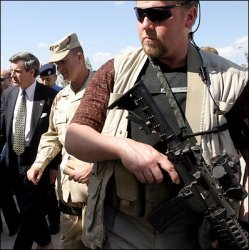
Iraq under Bremmer was the logical conclusion of Chicago School theory: a public sector reduced to a minimal number of employees, mostly contract workers, living in a Halliburton city state, tasked with signing corporate friendly laws drafted by KPMG and handling out duffel bags of cash to Western contractors protected by mercenary soldiers, themselves shielded by full legal immunity.
Seen from this perspective the documentary film No End In Sight by Charles Ferguson containing interviews with the bewildered participants of the Iraqi occupation including Retired Gen. Garner who can’t understand why the policy decisions were made now make sense, if only to the neocon true believers who made them – total destruction of a country so it can be rebuilt from a clean slate.
For the Bush administration, it was a natural evolution: after claiming it had a right to cause unlimited preemptive destruction, it then pioneered preemptive reconstruction – rebuilding places that have not yet been destroyed…
Until Iraq, the frontiers of the Chicago crusade had been bound by geography: Russia, Argentina, South Korea. Now a new frontier can open up wherever the next disaster strikes.
The oil and gas industry is so intimately entwined with the economy of disaster – both as root cause behind many disasters and as a beneficiary from them – that it deserves to be treated as an honorary adjunct of the disaster capitalism complex.
This discarding of 25 to 60 percent of the population has been the hallmark of the Chicago School crusade since the “misery villages” began mushrooming throughout the Southern Cone (South America) in the seventies. In South Africa, Russia, and New Orleans the rich build walls around themselves. Israel has taken this disposal process a step further: it has built walls around the dangerous poor.
Kline ends on a higher note. The “third way” of Chile’s Allende is reemerging throughout Latin America. The IMF and World Bank are in sharp decline with only a fraction of their peak loans and struggling to survive. Lebanese poor, Thai fishing villagers, and New Orleans neighborhoods are learning to take control of their own reconstruction and recovery. Chinese protests and demonstrations are forcing improved rural health care and education.
For a short film inspired by the book see Alfonso Cuaron’s Shock Doctrine

